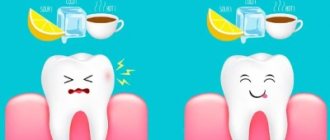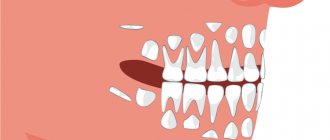Tooth loss is a disease in which, under the influence of negative factors, the integrity of the dentition is disrupted (due to the loss of one or more teeth). This disease is called edentulism.
Teeth are an important element of the human body. We lose them starting from childhood: healthy, strong teeth grow in place of lost milk teeth. Losing permanent teeth is a serious problem because a new tooth will not grow in the vacant space.
Causes of tooth loss
It is clear that teeth do not fall out on their own; this process is facilitated by various diseases of the periodontal tissue and gums. The reasons why a person may lose one or more teeth can be divided into objective and subjective. The first group includes phenomena that depend little on us or do not depend at all, the second group includes our erroneous actions or deliberate inaction.
Objective reasons
Chronic diseases are the main objective reason why seemingly healthy teeth begin to loosen and fall out: diabetes, cardiovascular diseases, stomach ulcers or duodenal diseases seriously affect the health of the oral cavity.
To better understand the nature of tooth loss, we will briefly talk about the negative effects of some chronic diseases. For example, diabetes is a disorder of blood sugar levels. Excess glucose leads to impaired blood supply to the gums, and due to impaired mineral metabolism, the enamel becomes thinner. A person with heart disease often takes medications that cause dry mouth, interfering with the normal functioning of the oral mucosa. Taking calcium antagonists (hypertension medications) can cause gum overgrowth.
One of the reasons leading to tooth loss is injury (as a result of an accident, while playing sports, during incidents). Often, after receiving a blow to the lower or upper jaw, you can lose one or more teeth.
Heredity is an important factor influencing the formation of a baby’s dental tissue in the mother’s womb. Poor nutrition and bad habits of the expectant mother can also affect the buds of teeth.
Subjective reasons
Failure to maintain oral hygiene leads to diseases of the gums and teeth. Lack of habit of regularly brushing your teeth to prevent pathogenic bacteria that penetrate under the gum tissue, forming tartar and plaque on the teeth.
The main enemies of the oral cavity are carbonated water and sugar, which, when combined, destroy tooth enamel and provide food for bacteria that destroy gums and dental tissue. They cause tooth decay and periodontitis, the most common diseases that occur in people who consume candy and soda.
Bad habits also make a destructive contribution to tooth loss - tobacco smoke contains a long list of toxic substances that do not add health to teeth and gums.
People cause some injuries to their teeth quite deliberately, for example, by opening bottle caps with their teeth. The fact that a tooth did not break due to such abuse does not mean that it will pass without a trace for him: in combination with other factors, everything can end in tooth loss.
Unfortunately, fears and worries about visiting the dental office and possible pain often repel patients from the opportunity to protect their teeth. No money? If a tooth falls out, the prosthesis will be much more expensive.
What to do if a filling falls out
Losing a filling is a common problem, but does not have any negative consequences other than the pain associated with the reopened nerve. If a temporary filling falls out at the most inopportune moment, try to contact your dentist as soon as possible. Given that the tooth cavity is opening up again, delaying the process of installing another filling can lead to aggravation of the problem, especially if food particles get into the tooth cavity.
Before starting treatment for a temporary filling that falls out, dentists determine the reason for the loss. Based on specific conditions, a certain material is selected, and treatment occurs using a certain technology. During the treatment, the remains of the previous filling are eliminated, the oral cavity is thoroughly processed, and then the damaged tooth is restored.
Until the dentist restores the lost filling and numbs the pain, the only possible measure the patient can take is not to place excessive stress on the damaged tooth. It is advisable to chew food on the other side of the jaw, and when brushing your teeth, treat the damaged area more carefully. It is also recommended to rinse your mouth more often to protect the damaged tooth from possible penetration of food debris with microbes and bacteria into it.
Statistics confirm that about 39% of people who complain about dental problems try to avoid visiting doctors. Fear of instruments and drills is quite justified, as is fear of possible discomfort when treating teeth and gums. However, it is precisely those patients who undergo systematic examination by dentists who avoid the biggest troubles throughout their lives. These include tooth loss.
Sign up for a free consultation >>
View prices
Making an appointment with a dentist
Diagnosis of tooth loss
If the first signs of disease are detected, and even more so of loose teeth. If the problem is ignored, the tooth will be lost forever. The doctor will ask you to take the necessary tests, take pictures, make a diagnosis, taking into account information about previous or existing diseases, and prescribe treatment. The main diagnostic methods are x-rays and, in some cases, dental computed tomography.
In the case when a patient suffers from a chronic disease, tooth loss is a consequence, the elimination of which will be an insufficient measure. The solution is comprehensive treatment of the underlying disease together with a specialized specialist.
Classification
Based on the identified clinical picture and x-ray examination, several types of pathology were identified .
Type I
The first type is characterized by supernumerary fusion, in which the second tooth is smaller . It is distinguished by its spiky shape and bumpy surface.
Most often, supernumerary specimens act as the second part.
Type II
This type is different in that fusion occurs only in the supragingival region, involving the enamel and a minimal layer of dentin.
III type
of fusion occurs at the root level in the area of the cementum . As a rule, in this case, the teeth are connected with deep damage to the dentin.
Moreover, both parts have the same shape and, practically, the same dimensions. The only difference can be in the length of the cutting part. The complementary part is already the main one.
IV type
The fourth stage is characterized by the fusion of dental tissues throughout the entire height of the tooth . Both the coronal and root parts are involved in the joining process.
In this case, the pulp chambers can be separated or merge into one cavity.
Treatment of tooth loss
There are few methods for treating tooth loss: therapeutic and surgical intervention. In the first case, when the first symptoms are detected, the dentist removes tartar, eliminates the consequences of caries, prescribes antibiotics, antiseptics, and medications that strengthen the general immune system. Together with constant and proper oral hygiene, this method will help to cure most diseases associated with tooth loss.
To save the tooth, surgical intervention may be necessary - an incision in the gum, removal of tartar and dead tissue. The incision is sutured; the operation takes from 40 minutes to 2 hours, depending on the complexity and volume of work.
If a tooth is lost or the dentist was forced to remove it, the patient will need dental prosthetics. This work is performed by a highly specialized specialist - a prosthetist dentist. In place of a missing tooth, you can place an implant - an artificial tooth root with a crown, implanted into the jaw, or a bridge - a ceramic crown attached to adjacent teeth.
What to do if a dead tooth breaks at the root?
“Doctor, I was just chewing a soft bun when I felt something crunch.” This is how the patient’s story usually begins about how it happened that some strange stump was left from the tooth. Is it possible to “save” the tooth from removal in such cases? What criteria does the dentist use in such cases? Finally, how exactly to properly restore a tooth in such situations - fill it with a filling, put a crown, “strengthen it with a pin” or something else? We'll talk about this today.
First, just a little theory. Why do dead teeth break so often ? By creating access to the root canals, the doctor removes quite a lot of tissue. In this case, as a rule, the need for root canal treatment is caused by advanced caries, which by the time of treatment has already “eaten” part of the tooth. As a result of these two reasons, after root canal treatment, the patient receives a severely weakened tooth. Some walls may be completely absent, some will be greatly thinned. Imagine an unopened can of cola... or beer (whichever is closer). Try to break it with your hands. This will not be easy to do. Now open it, drink the contents and you will get a model of the tooth with the insides removed and thin walls. You don’t have to be a beefy bodybuilder to be able to easily crush it with your hands. Much the same thing happens with dead teeth. Fragile walls cannot withstand large and constantly repeated cyclic loads during chewing. Our masticatory muscles can develop a force of up to 400 kg cm2. Imagine that such a 400-kilogram young man is riding on your tooth every day.
At the same time, it doesn’t matter at all what you eat: crackers, nuts or fresh bread. Sooner or later, the weakened walls of the tooth will crack. And this result is inevitable.
What to do if a tooth is broken? Should I delete it? Or can it be restored? And, if possible, how to do it better? The main criterion by which the doctor decides on the advisability of preserving the “hemp” is the quantity and quality of hard tissues rising above the gum. Ideally, it should be like this: the edges of the tooth along the entire perimeter are above the level of the gum, the height of the walls is at least 2-3 mm, the thickness is at least 1-2 mm.
Moreover, the higher and thicker the walls, the better the prognosis for restoration. If the tooth wall is chipped deep under the gum, then such teeth often have to be removed. Because no design with a good prognosis can be made for such teeth. If we neglect this rule, then in the very foreseeable future we will get something like this...
...the crown is in the hands, not in the mouth. Any filling, crown, whatever... will not last long on such a root. The main reason for this is that somewhere down there, in the depths of the gums, it is impossible to achieve a perfect fit of any material to the tooth. Any restoration, if done anyway, will begin to “leak” quite quickly under such conditions. This means that the infection living in the oral cavity will easily penetrate into the tooth, “undermining” the tooth from the inside. Therefore, it will be much more reliable to replace such a root with an implant. Of course, you can always find a compassionate dentist-plasterer who will stick something on, apply some grease and at the same time sleep peacefully. But if we are talking about quality and durability, then such options are not for us.
What then for us? Here are some possible correct options for restoring severely damaged dead teeth.
Restoring the tooth stump with a filling + crown.
For example, as in this clinical case. In such cases, a special composite material or amalgam is used to recreate the base of the tooth*
Restoration of the tooth stump with a filling on a fiberglass pin + crown.
Everything is the same, but the filling material is “strengthened” with a pin. This is usually done when there is very little tooth tissue and there is no particular hope for them.
There are many opinions on the advisability of “pinning” teeth, and even among dentists there is no unity on this topic. Some people put pins in all their teeth in a row, others don’t do them at all. The truth, as always, is somewhere in the middle. One thing is for sure - the use of the so-called. anchor metal pins (similar to small screws) today are bad manners.
Stump tab + crown.
In this case, the base for the crown is made in a dental laboratory and is a monolithic structure glued inside the canal. Stump inlays today can be made of metals (cobalt-chromium and gold-platinum alloys) or zirconium dioxide.
These are the main methods for restoring a tooth if it is broken. Each dentist makes the choice between them at his own discretion. The only thing you need to remember: any technique that involves installing a pin in the root canal requires their ideal treatment, because there will be no repeat relatively easy access to them. Therefore, any treatment with pins is in fact the last for the tooth, after which most often only removal is possible. For this and some other reasons, today there is a tendency to move away from the manufacture of any pin structures, especially stump inlays.
So now you know how and what is the best way to restore broken dead teeth.
Prevention of tooth loss
It is easier to prevent a disease than to treat it - this truism is remembered more often when the disease has progressed far and complex treatment is required. Tooth loss can be prevented by following these recommendations:
- Maintain personal oral hygiene: brushing your teeth should be done at least twice a day, morning and evening;
- use dental floss to clean the spaces between your teeth from food debris;
- Visit your dentist regularly, even if your teeth are not causing concern;
- strictly follow your dentist’s recommendations for dental care and disease prevention;
- take care of chronic diseases (if any);
- protect your teeth from injury.
Do teeth fall out on their own?
Yes, they fall out if they are dairy. In this case, changing teeth can be accompanied in children by acute painful sensations, swelling of the gums and sensitivity of the enamel, and in some cases even itching. If you experience these symptoms, it is important to seek the advice of a professional dentist. At the same time, while waiting to see which tooth falls out first, you should not forget about the child’s adequate nutrition so that the body and teeth in particular continue to receive all the necessary vitamins and microelements.
When a baby tooth falls out, the wound may continue to bleed for 5-10 minutes. Simply give your child a sterile gauze or cotton swab to bite on the area where the baby tooth has fallen out. If bleeding continues for a long time, be sure to take your baby to the pediatrician to check blood clotting. The help of a dentist may also be needed when baby teeth complicate the eruption of permanent teeth. In this case, the teeth are forcibly removed.











